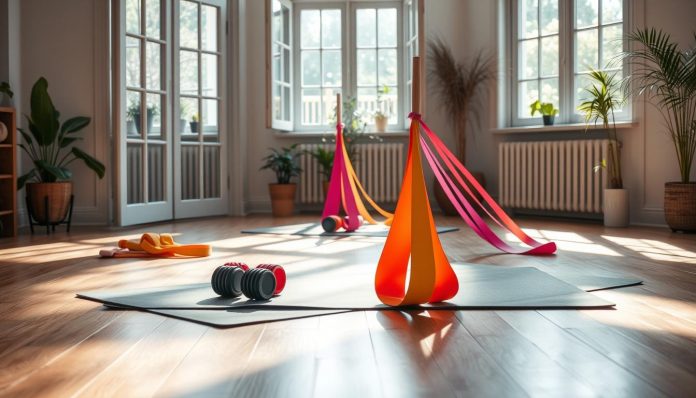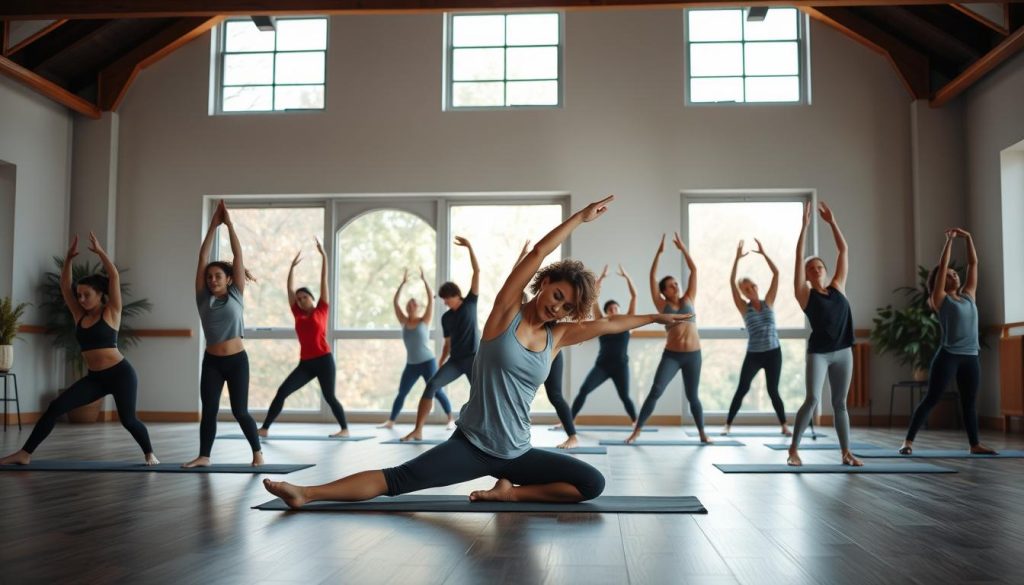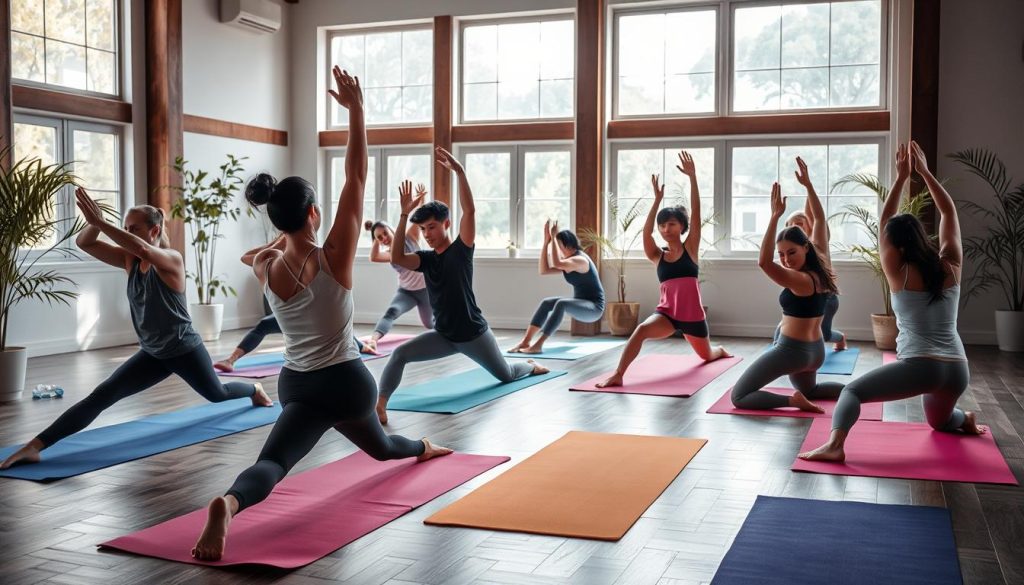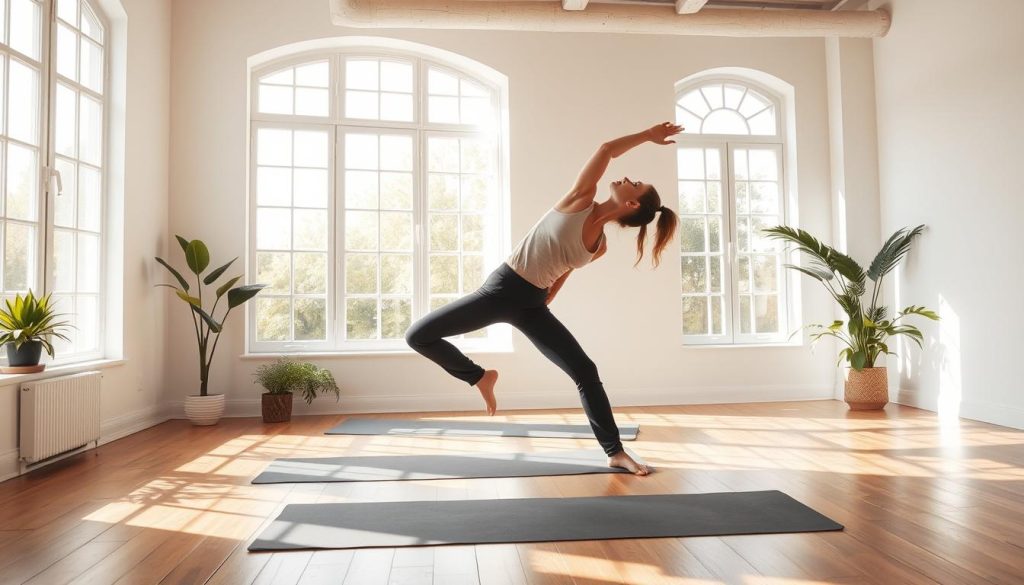Improving your flexibility can greatly benefit your health and well-being. Adding flexibility exercises to your daily routine can boost your range of motion and reduce muscle soreness. It also enhances your athletic performance. To start, understanding the importance of flexibility and how to improve it with simple stretches is key.
Exploring flexibility exercises reveals that it’s not just about touching your toes or doing complex yoga poses. Simple stretches can be effective for anyone, regardless of age or fitness level. Regular stretching can lead to many benefits, including a lower risk of injury and better physical health. The question of how to improve your flexibility with these easy stretches has a straightforward answer.
With practice and patience, you can enhance your flexibility and enjoy its many benefits. Whether you’re an athlete or just want to feel more limber, starting with these easy stretches is a good idea. By making stretching a daily habit, you’re on your way to a healthier, happier life.
Key Takeaways
- Improving flexibility can increase range of motion and reduce muscle soreness
- Flexibility exercises, such as stretching, can be simple and effective
- Regular stretching can reduce risk of injury and improve overall physical health
- How to improve your flexibility with these easy stretches is a simple and achievable goal
- Flexibility exercises can be done by anyone, regardless of age or fitness level
- Committing to a regular stretching routine can have numerous health benefits
Understanding Flexibility and Its Benefits
Starting your journey to better flexibility is exciting. It’s important to know what flexibility is and its benefits. Flexibility is how far your joints can move. Regular stretching can improve this.
The Mayo Clinic says flexibility helps prevent injuries and reduces muscle pain. Adding stretching to your routine can make you more flexible and less likely to get hurt.
The National Institute on Aging suggests four types of exercise, including stretching. Stretching improves joint flexibility and makes daily tasks easier. Hold each stretch for 30 seconds, and longer for tight areas.
Consistency is key when improving flexibility. Stretch at least 2 to 3 times a week for best results. Short sessions of 5 to 10 minutes can keep you flexible. Making stretching a daily habit brings many benefits, like less injury risk and better movement.
What is Flexibility?
Flexibility lets your joints move fully. It’s a key part of fitness and gets better with stretching. Being more flexible means you can move better and avoid injuries.
Health Benefits of Improved Flexibility
Improved flexibility offers many health benefits. Stretching regularly can make you more flexible, loosen muscles, and lower injury risk. It also makes moving around easier.
How Flexibility Impacts Daily Life
Flexibility greatly affects daily life, making tasks simpler. Being more flexible means you’re less likely to get hurt and can move better. It’s vital for staying mobile and independent, whether you’re active or just doing daily chores.
Getting Started: Basic Principles of Stretching
To start improving your flexibility, it’s key to know the basics of stretching. Before you begin, make sure to warm up properly. This warm-up should increase your body temperature by 1 to 2 degrees Celsius. You can achieve this with at least 5 minutes of aerobic activity.
This warm-up boosts muscle performance and flexibility. It also lowers the risk of injury.
Proper breathing is also important when stretching. Breathing comfortably is a must for good stretching results. Breathe in through your nose and out through your mouth. This helps your body relax and stretch better.
Always listen to your body while stretching. Stop if you feel pain or discomfort. This prevents muscle damage from overstretching.
By sticking to these basic principles, you’ll enhance your flexibility and fitness. Hold stretches for a few seconds at a time. Stretch slowly and gently.
With regular practice and patience, you’ll see improvements. You’ll increase your range of motion, improve your posture, and lower injury risks. This will help you enjoy the benefits of stretching and improve your overall health.
Easy Stretches for Beginners
Starting your flexibility training journey is exciting. It’s key to begin with simple stretches for key body areas. The neck and shoulders often get tight, causing discomfort and less mobility. Stretching these spots can boost flexibility and ease tension, says the Mayo Clinic.
Proper technique and breathing are vital in flexibility training. They ensure you get the most from your stretches and avoid injuries. Adding easy stretches to your daily routine can enhance flexibility and movement.
Beginners can start with the neck and shoulder stretches. For the neck stretch, gently tilt your head to the side, bringing your ear to your shoulder. Hold for 10-30 seconds, then switch sides. The shoulder stretch involves holding your arm straight and using the other arm to pull your hand towards your shoulder blade. Hold for 10-30 seconds and switch sides.
Neck Stretch
This stretch eases tight neck muscles and boosts flexibility. Breathe deeply and slowly while stretching to maximize your flexibility training.
Shoulder Stretch
This stretch eases shoulder tension and improves movement. Adding these simple stretches to your daily routine can enhance flexibility and lower injury risks.
Lower Body Stretches to Enhance Flexibility
As you keep up with your flexibility workout, focusing on lower body stretches is key. The Mayo Clinic says stretching hamstrings, quadriceps, and calf muscles boosts flexibility and lowers injury risk. Adding these stretches to your routine can also enhance your range of motion and ease muscle tension.
A good flexibility workout covers various stretches for different muscles. Lower body stretches are vital, targeting hamstrings, quadriceps, and calf muscles. The American Heart Association suggests warming up before stretching to avoid discomfort. Start with basic stretches like hamstring, quadriceps, and calf stretches.
Hamstring Stretch
To do a hamstring stretch, sit on the floor with legs straight out. Lean forward, trying to touch your toes, and hold for 10-30 seconds. This stretch boosts flexibility and lowers injury risk.
Quadriceps Stretch
For a quadriceps stretch, stand with one hand on a wall for balance. Bend one knee, with your foot behind you, and hold for 10-30 seconds. This stretch improves flexibility and eases quadriceps tension.
Calf Stretch
To stretch your calf, stand facing a wall with one hand on it for balance. Step back a foot, keeping your heel down. Bend your front knee and lean forward, stretching your calf. Hold for 10-30 seconds and switch sides.
Hold each stretch for 10-30 seconds and repeat 3-5 times. Regular practice enhances flexibility and reduces injury risk. Adding these stretches to your flexibility workout helps reach fitness goals and boosts overall health.
Upper Body Stretches for Better Mobility
To boost flexibility and ease upper body tension, add specific stretches to your routine. The Mayo Clinic suggests stretching the upper body to enhance mobility and ease tension. Focus on the chest, upper back, and wrists to improve flexibility and movement.
Regular stretching can cut injury rates by 30%. Stretching after workouts can also boost recovery by about 25%, helping muscles heal. Chest stretches are key in fighting the effects of bad posture, common in 70% of people with desk jobs.
Chest Opener Stretch
This stretch boosts chest flexibility and eases tension. Stand in a doorway with hands on the doorframe at shoulder height. Lean forward to stretch your chest and hold for 30 seconds.
Upper Back Stretch
This stretch improves upper back flexibility and reduces tension. Sit or stand with arms by your sides. Squeeze your shoulder blades together and hold for 30 seconds.
Adding these upper body stretches to your routine can enhance flexibility, reduce tension, and improve mobility. Hold each stretch for 20 to 30 seconds to boost muscle and joint flexibility. Regular practice will help you enjoy the benefits of stretching and improve your health.
Incorporating Dynamic Stretching
As you move forward in your flexibility journey, adding dynamic stretching is key. It helps increase flexibility and boosts performance. Dynamic stretching mimics the actions you’ll do, warming up your muscles.
This type of stretching raises muscle temperature and blood flow. It lets you move more freely.
The National Institute on Aging says dynamic stretching boosts flexibility and balance. The Mayo Clinic suggests adding it to your workout to get fitter. It also cuts down injury risk and boosts performance.
What is Dynamic Stretching?
Dynamic stretching involves quick movements, lasting 1 to 2 seconds. This is different from static stretches, which you hold for 15 to 60 seconds. Leg swings, arm circles, and hip circles are examples.
These movements increase blood flow and lower muscle stiffness. They make it easier to move and do daily tasks.
Benefits of Dynamic Movements
Dynamic stretching offers many benefits. It improves flexibility, speed, and agility, and enhances performance. Adding it to your routine reduces injury risk and boosts fitness.
It also improves balance and coordination. This makes it a great addition to any workout.
Always warm up before starting dynamic stretches. Listen to your body and adjust the intensity and duration as needed. With regular practice, you can increase flexibility and enhance flexibility to reach your fitness goals.
Static vs. Dynamic Stretching: What to Choose?
When it comes to flexibility training, you have two main options: static and dynamic stretching. It’s important to know the difference between these two to make a good flexibility workout plan. Static stretching means holding a stretch for 20-30 seconds to stretch the muscle. Dynamic stretching, on the other hand, involves moving your joints while keeping your muscles active.
A study by the Mayo Clinic suggests mixing both static and dynamic stretching for the best results. This mix can boost your flexibility training and lower injury risk. Adding dynamic stretching to your flexibility workout can also improve blood flow, making your muscles more flexible and ready for exercise.
It’s important to remember that static stretching can temporarily lower strength by 5-30%. It’s best used after working out. Dynamic stretching, on the other hand, can improve speed and agility by up to 10%. Knowing the pros and cons of each can help you craft a balanced flexibility workout routine that fits your needs and goals.
Key Differences
The main differences between static and dynamic stretching are their approaches and benefits. Static stretching is great for improving flexibility and range of motion. Dynamic stretching is better for boosting athletic performance and reducing injury risk.
When to Use Each Type
Use static stretching after a workout to aid in recovery and improve flexibility. Dynamic stretching is ideal for before working out, as it increases blood flow and prepares your muscles.
Combining Both for Optimal Results
By mixing static and dynamic stretching, you can make a complete flexibility training program. Make sure to listen to your body and adjust your routine as needed. This way, you’ll get the most out of your flexibility workout.
Creating a Stretching Routine
To boost flexibility, make a stretching plan that fits your life and goals. Start with simple stretches in your daily routine, like morning stretches. These can be quick, lasting from 5 to 15 minutes, and greatly improve your flexibility. The American College of Sports Medicine suggests stretching two to three times a week. For more tips, check out daily stretching routines.
When setting up your routine, think about how long to hold each stretch. Hold each stretch for 10-30 seconds and do it three to five times. As you get better, aim to hold stretches for up to 30 seconds. Keeping track of your progress helps you adjust your routine to keep improving.
Always listen to your body and tweak your routine if needed. If you’re new, start with shorter holds and slowly increase them. Adding stretches to your daily routine boosts mobility and lowers injury risk. Stay consistent and patient, adjusting your routine as needed to enhance flexibility and well-being.
Tips for Staying Motivated with Stretching
Keeping up with stretching can be tough, but it’s doable with the right mindset. Start by setting goals that fit your fitness level and lifestyle. Aim for small, achievable steps and celebrate each success.
Make stretching a part of your daily routine. Use your work breaks or fit it in before or after workouts. Having a stretching buddy can make it more fun and keep you on track.
Improving flexibility takes time and effort. Stay committed to your routine and track your progress. Don’t get discouraged by setbacks. With patience and dedication, you’ll see real improvements in your flexibility and overall health.
FAQ
What is flexibility and why is it important?
Flexibility is how far your joints can move and how much your muscles can stretch. It helps prevent injuries, boosts your physical performance, and makes daily tasks easier.
What are the health benefits of improved flexibility?
Being more flexible can reduce muscle tightness, improve your posture, and enhance blood flow. It also boosts your physical and mental health, preventing injuries and improving movement.
How do I properly warm up before stretching?
Warm up your muscles before stretching to get blood flowing and prepare your body. Start with 5-10 minutes of light activity, like walking or jogging.
What are some easy stretches for beginners to try?
Beginners can start with neck, shoulder, hamstring, quadriceps, and calf stretches. These exercises target key muscle groups and can enhance flexibility.
What is the difference between static and dynamic stretching?
Static stretching involves holding a stretch for 30 seconds or more. Dynamic stretching uses controlled movements to boost range of motion. Mixing both can improve flexibility best.
How often should I stretch, and how do I track my progress?
Stretch 2-3 times a week, for 10-15 minutes each time. Measure your range of motion or flexibility to track progress and adjust your routine as needed.
What tips can help me stay motivated with stretching?
Set achievable goals, make stretching a daily habit, and find a stretching partner. Celebrate small wins and track your progress to stay motivated and improve your flexibility.




